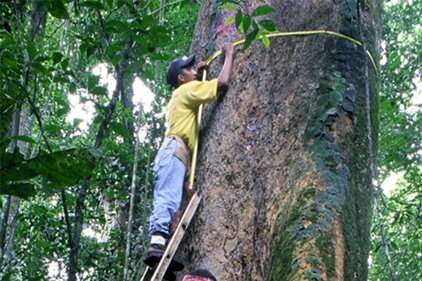Researchers assemble first comprehensive list of Panama's trees with geographic ranges

Central America is one of the most diverse floristic regions in the world, but a lack of comprehensive plant records and knowledge of its endangered, endemic tree species impedes conservation work.
In a new research paper published in Forest Ecosystems, The Morton Arboretum Center for Tree Science Research Fellow Richard Condit, Ph.D., provided the first comprehensive checklist to include geographic ranges by using an innovative, repeatable method for assessing extinction risk of trees in poorly studied areas. The method involves synthesizing field data with available online records to form a fully vetted list of the trees of Panama and their estimated geographic ranges. These range sizes provide a quantitative basis for assessing extinction risk of poorly studied tropical tree species, and offer a starting point for researchers to plan conservation efforts.
"A fundamental question in species conservation is, how many are left?" said Condit, who has studied the trees of Panama for 35 years. "Full geographic ranges of individual species are seldom known, and we found that the forest inventory plots being studied in the country lacked a global geographic perspective. Now that we have estimated range sizes, we can compare Panama's ecosystem to the rest of the world, as well as plan and allocate conservation resources more effectively."
The authors estimate that 16.2% of Panama's 3,043 tree species had ranges less than 20,000 km2, a range that often signals a status of endangered, according to the International Union for Conservation of Nature (IUCN) standards. This percentage of narrow endemics is proportionate to that of North America. Researchers also noted that the country's tree census plots excluded rare endemic species, noting that the network of 66 tree plots captured 27% of total tree flora in Panama, but only 7.5% of narrow endemics.
The Morton Arboretum conducted the research as part of its efforts to prevent global tree extinctions and secure threatened species in Central America and beyond.
"This was the first comprehensive effort to pull together global databases, rigorously vet all the data, and create a comprehensive distribution of species in an understudied country like Panama," said Chuck Cannon, Ph.D., director of the Center for Tree Science at The Morton Arboretum. "Richard and his team have given us a strategy for finding where to go, what trees to study, and how to be more effective in the Arboretum's efforts to conserve rare tree species around the world."
The next step for Condit and his team is to estimate population sizes and make demographic assessments of extinction risk, starting with the potential red-listed trees located on tree census plots.
More information: Richard Condit et al, Trees of Panama: A complete checklist with every geographic range, Forest Ecosystems (2020). DOI: 10.1186/s40663-020-00246-z
Provided by The Morton Arboretum



















